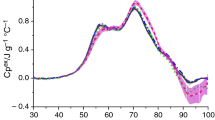Abstract
The pattern of several blood–gas indices has been investigated in eight show jumpers during a 2-day showjumping event. The effectiveness of the athlete horse’s physiological buffering systems has been pointed out, as well as the similarity between the patterns of the indices regarding the acid–base status and those metabolically defining the horse’s physical potential. The results of this study draw attention to the importance of a qualitative and quantitative determination of the blood–gas parameters in the show jumper, not only to define the horse’s acid–base status but also to analyse the potential performance more accurately.



Similar content being viewed by others
Abbreviations
- pCO2:
-
Partial pressure of carbon dioxide
- pO2:
-
Partial pressure of oxygen
- SO2%:
-
Oxygen saturation
- Hb:
-
Haemoglobin
- Hct:
-
Haematocrit
- BE-ecf:
-
Base excess of extracellular fluid
- BE-b:
-
Base excess of the blood
- SBC:
-
Standard bicarbonates concentration
- HCO −3 :
-
Bicarbonates concentration
- TCO2:
-
Total carbon dioxide
- O2Ct:
-
Oxygen content
References
Aguillera-Tejero E, Bas S, Estepa J, Lopez I, Mayer-Valor R, Rodriguez M (1998) Acid–base balance after exercise in show jumpers. Conf Equine Sport Med Sci 12:43–45
Barrey EVJ (1992) Measurement of heart rate, blood lactate and haematological parameters during show jumping competitions ranging from regional to international level. In: Proceedings of the association of equine sports medicine. Veterinary Practice, Santa Barbara, California
Bayly W, Grant B, Breeze RG, Kramer JW (1983) The effect of maximal exercise on acid–base balance and arterial blood gas tension in the thoroughbred horse. In: Snow DH, Persson SBG, Rose RJ (eds) Equine exercise physiology. Granta Editions, Cambridge, pp 400–407
Beadle R (1985) Gas transport to and from the periphery. In: Jones WE (ed) Equine Sports Medicine. Lea and Febiger, Philadelphia, pp 36–43
Carlson G (1983) Thermoregulation and fluid balance in the exercising horse. In: Snow DH, Persson SBG, Rose RJ (eds) Equine exercise physiology. Granta Editions, Cambridge, p 291
Clerbaux T, Serteyn D, Willems E, Brasseur L (1986) Determination of the standard oxyhemoglobin dissociation curve in horses. Effects of temperature, pH and diphosphoglycerate. Can J Vet Res 50:188–192
Corazza M, Buonaccorsi A, Ercolini F, Barsaglini M (1995) Valutazione dello stato di forma del cavallo atleta: lattacidemia e parametri emogasanalitici. Riv Soc Ital Ippologia 1:5–10
Gaesser G, Brooks G (1984) Metabolic bases of post-exercise oxygen consumption. Med Sci Sports Exerc 16:29
Gollnick P, Bertocci L, Kelso T, Witt E, Hodgson D (1990) The effect of high-intensity exercise on the respiratory capacity of skeletal muscle. Pflugers Arch 415:407–413
Gore J, Withers R (1990) Effects of exercise intensity and duration on post-exercise metabolism. J Appl Physiol 68:2362
Hinchcliff K, Lauderdale M, Dutson J, Geor R, Lacombe V, Taylor L (2002) High intensity exercise conditioning increases accumulated oxygen deficit of horses. Equine Vet J 34:6–7
Johnson P (1995) Electrolyte and acid–base disturbances in the horse. Vet Clin N Am Equine 11:491–495
Judson G, Frauenfelder H, Mooney G (1983) Biochemical changes in thoroughbred racehorse following submaximal exercise. In: Snow DH, Persson SBG, Rose RJ (eds) Equine exercise physiology. Granta Editions, Cambridge, p 408
Lacombe V, Hinchcliff K, Geor R, Lauderdale M (1999) Exercise that induces substantial muscle glycogen depletion impairs subsequent anaerobic capacity. Equine Vet J Suppl 30:293–297
Lacombe V, Hinchcliff K, Geor R, Baskin C (2001) Muscle glycogen depletion and subsequent replenishment affect anaerobic capacity of horses. J Appl Physiol 91:1782–1790
Snow D, Ricketts S, Douglas T (1983) Post-race blood biochemistry in the thoroughbred. In: Snow DH, Persson SBG, Rose RJ (eds) Equine exercise physiology. Granta Editions, Cambridge, p 389
Stampfli H, Misiaszek J, Lumsden G, Carlson G, Heigenhauser J (1999) Weak acid-concentration Atot and dissociation constant Ka of plasma protein in racehorses. Equine exercise physiology, vol 5. Equine Vet J Suppl 30:438–442
Author information
Authors and Affiliations
Corresponding author
Rights and permissions
About this article
Cite this article
Piccione, G., Ferrantelli, V., Fazio, F. et al. Blood–gas profile in the show jumper undergoing increasing workloads during a 2-day event. Comp Clin Path 13, 43–50 (2004). https://doi.org/10.1007/s00580-004-0518-2
Received:
Accepted:
Published:
Issue Date:
DOI: https://doi.org/10.1007/s00580-004-0518-2




